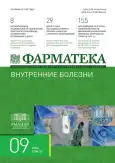Prevalence and risk factors for the development of dermatophytosis. experience in treating the “transformed variant” of microsporia with systemic and local terbinafine
- Authors: Svechnikova E.V.1,2, Zhufina S.E.1
-
Affiliations:
- Polyclinic No. 1 of the Administrative Directorate of the President of the Russian Federation
- Russian Biotechnological University (ROSBIOTECH)
- Issue: Vol 31, No 9 (2024)
- Pages: 125-130
- Section: Dermatology/allergology
- URL: https://journal-vniispk.ru/2073-4034/article/view/294177
- ID: 294177
Cite item
Abstract
Fungal infections are an important public health problem due to their high prevalence worldwide (20–25% of the population is infected); dermatophytes of the Microsporum, Trichophyton, Epidermophyton, and Candida genera are the most common pathogens. The nature and frequency of detection of this pathology is influenced by the climate in a particular region and the socio-economic status of the population. Dermatomycetes lead to damage to nails, skin of the feet and hands, scalp, smooth skin and folds. Infection is possible through contact with a sick person or animal, or with the patient’s personal belongings. Risk factors include damage to the integrity of the skin, increased sweating or dry skin, changes in skin pH, and poor hygiene. However, the main reason for contamination with dermatomycetes is the presence of chronic diseases of the endocrine, cardiovascular, circulatory systems, metabolic and oncological diseases. Long-term use of systemic and local glucocorticosteroid drugs (GCS), cytostatics, irrational antibacterial therapy; the presence of the human immunodeficiency virus, smoking, and heavy physical labor contribute to the chronicity of fungal infection, poor response to antifungal therapy, and can cause a recurrent course. Also in practice, there are often cases of modification of the clinical picture of dermatophytosis as a result of the influence of the above factors and incorrect therapy. The article discusses the clinical case of a patient with late diagnosis of mycosis of smooth facial skin, developing against the background of diabetes mellitus and long-term use of local combined corticosteroids. Possible causes, differential diagnosis with other dermatoses and methods for diagnosing the “transformed” variant of microsporia (Tinea incognito) are also outlined. Successful diagnosis and effective treatment with local and systemic terbinafine led to the patient’s recovery and avoided the development of complications. Terbinafine has shown high efficacy, safety, local availability, and ease of use, which increases the likelihood of treatment compliance and patient’s and physician adherence to treatment.
Keywords
Full Text
##article.viewOnOriginalSite##About the authors
E. V. Svechnikova
Polyclinic No. 1 of the Administrative Directorate of the President of the Russian Federation; Russian Biotechnological University (ROSBIOTECH)
Author for correspondence.
Email: elene-elene@bk.ru
ORCID iD: 0000-0002-5885-4872
Dr. Sci. (Med.), Professor at the Department of Skin and Sexually Transmitted Diseases, Russian Biotechnological University (ROSBIOTECH); Head of the Department of Dermatovenereology and Cosmetology, Polyclinic No. 1 of the Administrative Directorate of the President of the Russian Federation
Russian Federation, Moscow; MoscowS. E. Zhufina
Polyclinic No. 1 of the Administrative Directorate of the President of the Russian Federation
Email: elene-elene@bk.ru
ORCID iD: 0000-0001-5694-2847
Russian Federation, Moscow
References
- Клинические рекомендации «Микозы кожи головы, туловища, кистей и стоп» Общероссийская общественная организация «Российское общество дерматовенерологов и косметологов». 2020 г. [Clinical recommendations «Mycoses of the scalp, trunk, hands and feet» All-Russian public organization «Russian Society of Dermatovenerologists and Cosmetologists». 2020. (In Russ.)].
- Kovitwanichkanont T., Chong A.H. Superficial fungal infections. Aust J Gen Pract. 2019;48(10):706–11. doi: 10.31128/AJGP-05-19-4930.
- Verma S.B., Panda S., Nenoff P., et al. The unprecedented epidemic-like scenario of dermatophytosis in India: III. Antifungal resistance and treatment options. Indian J Dermatol Venereol Leprol. 2021;87(4):468-482. doi: 10.25259/IJDVL_303_20.
- Аймолдина А.А., Батпенова Г.Р., Алгазина Т.О. и др. Распространенность дерматофитий и их влияние на качество жизни пациентов в мире. Наука и Здравоохранение. 2023;4(25):246–57. doi: 10.34689/SH.2023.25.4.030 [Aimoldina A.A., Batpenova G.R., Algazina T.O., et al. Рrevalence and impact on life quality of dermatophytosis in the world. Sci. Healthcare. 2023;4(25):246–57. (In. Russ.)].
- Окладников С.М., Никитина С.Ю. и др. Здравоохранение в России. 2023: Стат. сб., Росстат. М., 2023. 179 с. [Okladnikov S.M., Nikitina S.Yu. et al. Healthcare in Russia. 2023: Statistical collection, Rosstat. М., 2023. 179 р. (In. Russ.)].
- Sooriya S., Jayapalan S., Mini G., et al. Chronic Dermatophytosis: Clinico-Mycological Determinants and Antifungal Susceptibility Pattern. Indian J Dermatol. 2021;66(3):329. doi: 10.4103/ijd.IJD_283_20.
- Son J.H., Doh J.Y., Han K., et al. Risk factors of dermatophytosis among Korean adults. Sci Rep. 2022;12(1):13444. doi: 10.1038/s41598-022-17744-5.
- Singh S., Verma P., Chandra U., et al. Risk factors for chronic and chronic-relapsing tinea corporis, tinea cruris and tinea faciei: Results of a case-control study. Indian J Dermatol Venereol Leprol. 2019;85:197–200. doi: 10.4103/ijdvl.IJDVL_ 807_17.
- Sasagawa Y. Internal environment of footwear is a risk factor for tinea pedis. J Dermatol. 2019;46:940–46. doi: 10.1111/1346-8138.15060.
- Rodriguez-Cerdeira C. , et al. A systematic review of worldwide data on tinea capitis: Analysis of the last 20 years. J Eur Acad Dermatol Venereol. 2021;35:844–83. Doi: 10.1111/ jdv.16951.
- Kim M.W., Park H.S., Bae J.M., et al. Tinea Incognito with Folliculitis-Like Presentation: A Case Series. Ann Dermatol. 2018;30:97–9. doi: 10.5021/ad.2018.30.1.97.
- Froidefond M., Dudouet P., Ranque S., Cassir N. Tinea incognito: Primum non nocere. Int J Infect Dis. 2021;103:597–98. doi: 10.1016/j.ijid.2020.11.136.
- Nowowiejska J., Baran A., Flisiak I. Tinea Incognito-A Great Physician Pitfall. J Fungi (Basel). 2022;8(3):312. doi: 10.3390/jof8030312.
- Lekkas D., Ioannides D., Lazaridou E., et al. Dermatoscopy of tinea corporis. J Eur Acad Dermatol. Venereol. 2020;34:e278–80. doi: 10.1111/jdv.16277.
- Summary of the Product Characteristics: Terbinafine. [(accessed on 25 February 2022)]; Available on-line: https://www.medicines.org.uk/emc/product/7133/smpc#gref.
- Leung A.K., Barankin B., Lam J.M., et al. Tinea versicolor: an updated review. Drugs Context. 2022;11:2022-9-2. Doi: 10.7573/ dic.2022-9-2.
- Kreijkamp-Kaspers S., Hawke K., Guo L., et al. Oral antifungal medication for toenail onychomycosis. Cochrane Database Syst Rev. 2017;7:CD010031. doi: 10.1002/14651858.CD010031.pub2.










